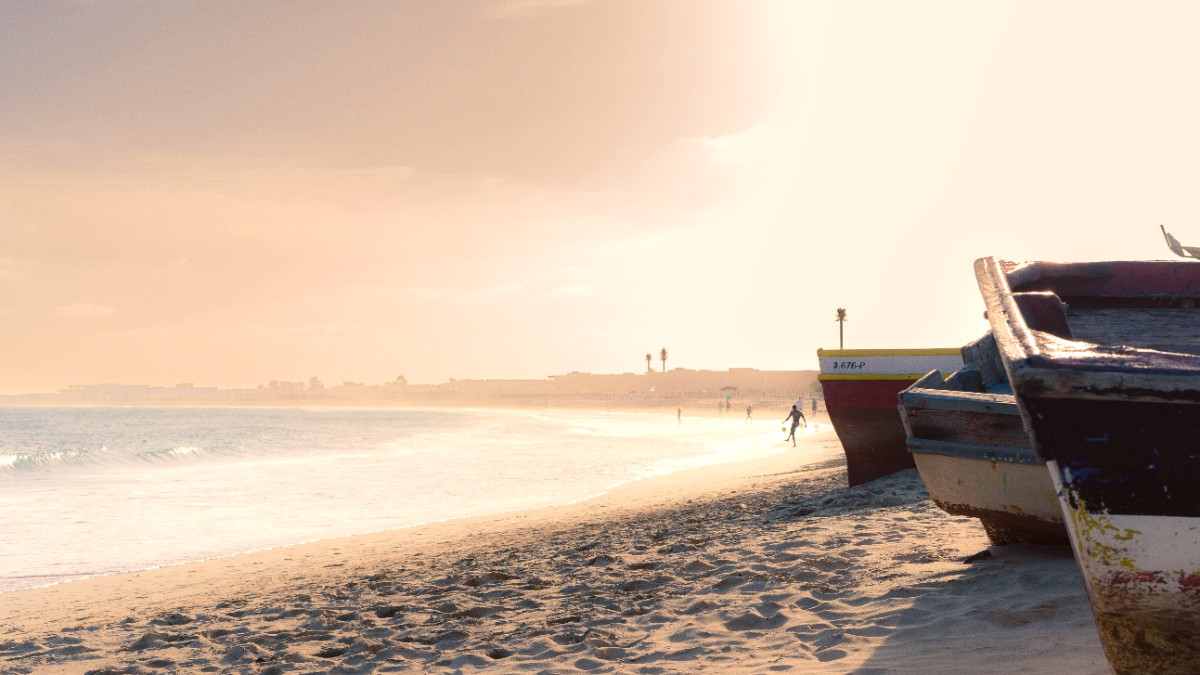
Cabo Verde
Boa Vista features several iconic landmarks that capture the island's unique charm and history. These must-visit sites carry historical and cultural context.
Sal Rei: The main town, a living landmark. Its colorful buildings, bustling main square (Praça de Sal Rei), and active port area share a glimpse into local life. Wander through its streets to feel the island's rhythm.
Boa Vista's cultural offerings focus on lived experiences and local interactions rather than traditional institutions.
Near Sal Rei, these offer remnants of past industry. These pans, which gave the town its name, illustrate salt production's historical importance to the island's economy.
While no longer active on a large scale, they provide a visual link to Boa Vista’s commercial past.
Boa Vista's landscape defines itself by its beaches, desert-like interiors, and unique ecosystems, making it a natural paradise.
A stunning mini-desert of white sand dunes, transported by wind from the Sahara. This unique landscape, with its undulating patterns, sets a perfect scene for photography and a sense of vastness.
Often cited as one of the most beautiful beaches in the world, stretching 18 kilometers (11 miles) of pristine white sand. Its sheer scale and untouched beauty make it a beach lover's must-visit.
The island's highest point. An old lighthouse stands here, with panoramic views across the island and out to the Atlantic. Access often needs a 4x4 vehicle.
Mainly on eastern and southern beaches (e.g., Praia de Ervatão, Praia de Curral Velho) during nesting season (June-October). Strict regulations call for guided tours only to protect these vulnerable creatures.
Humpback whales visit coastal waters from March to May. Boat tours are opportunities to observe these magnificent marine mammals.
Various endemic and migratory bird species are seen, especially near wetlands like Rabil Lagoon. This brackish water lagoon near the airport is an important bird area.
Boa Vista is largely arid, so formal parks and cultivated gardens are scarce. The landscape characterizes itself by desert and pristine beaches. Beauty lies in its raw, natural state.
Boa Vista’s volcanic origins are visible in the island's rocky interior and coastline. Vast "desert" areas with sand dunes, formed by Saharan winds, represent an unique geological phenomenon distinguishing the island.
Boa Vista is famous for long, unspoiled beaches like Santa Monica, Praia de Chaves, Praia de Ervatão, and Praia do Estoril. These locations are for swimming, sunbathing, and water sports. Rabil Lagoon is a brackish water lagoon and important bird area.
Beyond well-known attractions, Boa Vista holds several hidden gems. These off-the-beaten-path locations hold unique experiences and a quieter glimpse into the island's character.
To make the most of your sightseeing, consider booking tours for convenient access and expert guidance.
For a wide selection of tours and tickets, including options for Boa Vista's attractions, check GetYourGuide.
Explore the island's diverse landscapes and iconic spots with guided tours. These often include the Shipwreck and Viana Dunes.
Witness Boa Vista's incredible marine life with specialized boat trips.
Discover the island's heritage with walking tours in Sal Rei and nearby villages.
For a personalized experience, arrange private tours catering to specific interests.
Discover Boa Vista's lesser-known treasures and get insider tips for an unique experience.
A deserted village in the south. Its abandoned houses and streets offer an eerie glimpse into the past; stories of communities that once thrived here unfold.
A small, charming chapel with striking blue and white colors, on a cliff overlooking the sea. Its remote, scenic location makes for a peaceful and picturesque stop.
Features impressive rock formations and caves on the southwestern coast. Natural erosion has carved intricate shapes, creating fascinating photographic opportunities.
Smaller, inland villages like João Galego, Fundo das Figueiras, and Cabeça dos Tarafes offer a more authentic glimpse into rural Cape Verdean life.
Still largely undeveloped, these are gaining interest for their pristine nature and quietude. These areas allow experience of Boa Vista's untouched beauty before wider development.
Most popular sites can become busy with tour groups during midday. Visit early morning or late afternoon for cooler temperatures and fewer crowds.
Take a boat trip around the islet before landing to capture panoramic views of the fort and the Sal Rei coastline. Climb to the fort ruins for unique perspectives.
Generally safe, but always exercise caution with personal belongings in crowded areas. When visiting remote beaches, do not leave valuables unattended.
For a wide selection of tours and tickets, including options for Boa Vista's attractions, check GetYourGuide.
Boa Vista's natural beauty shines brightest. Venture beyond the resorts to truly experience the island's unique charm, from the Saharan dunes to untouched beaches.
Always respect local customs and the environment, especially when visiting protected areas or engaging with wildlife.
For most major attractions, organized tours (by 4x4, quad bike, or bus) are the most straightforward and safest way to explore.
Taxis are readily available in Sal Rei. "Aluguers" are shared taxis following fixed routes, a more budget-friendly option for local transport.
Car rental is available, but a 4x4 vehicle is highly recommended for exploring beyond paved roads.
Walking is feasible within Sal Rei. Cycling is also an option, especially with fat bikes for sandy terrain.
Ideal for short distances and specific terrain.
For Ilhéu de Sal Rei and other coastal views, boat trips from Sal Rei beach are available.
Essential for islet and coastal excursions.
Many roads outside Sal Rei are unpaved and sandy. Proper vehicle choice is very important for comfort and accessibility.
Consider hiring a local guide for exploring remote areas. Their knowledge of the terrain and local conditions is very valuable.
Always prioritize safety. Inform someone of your plans if venturing to remote areas, especially for independent hikes or drives.